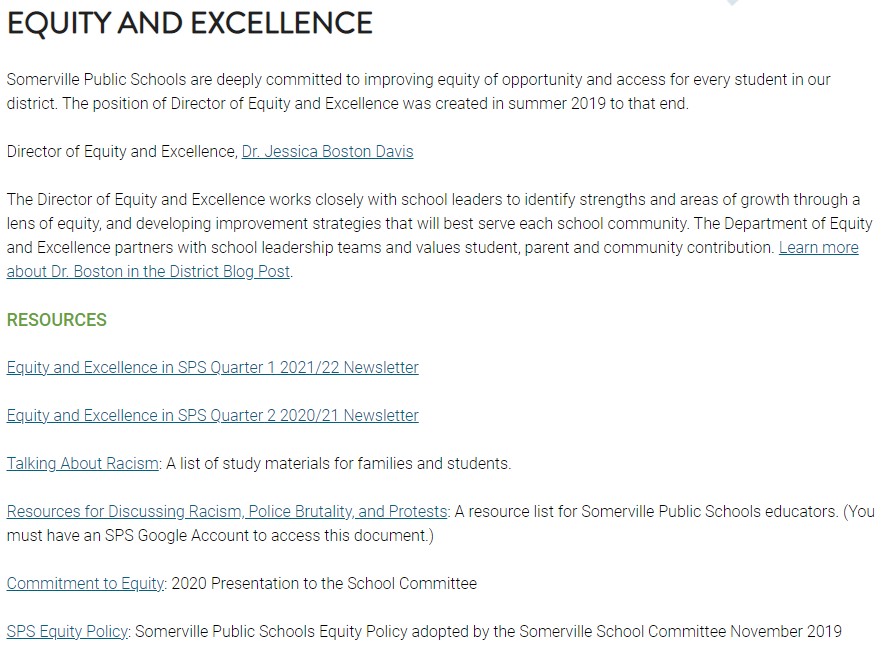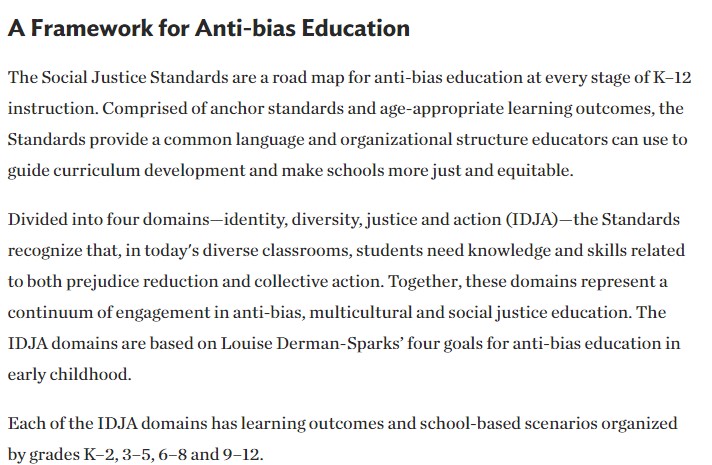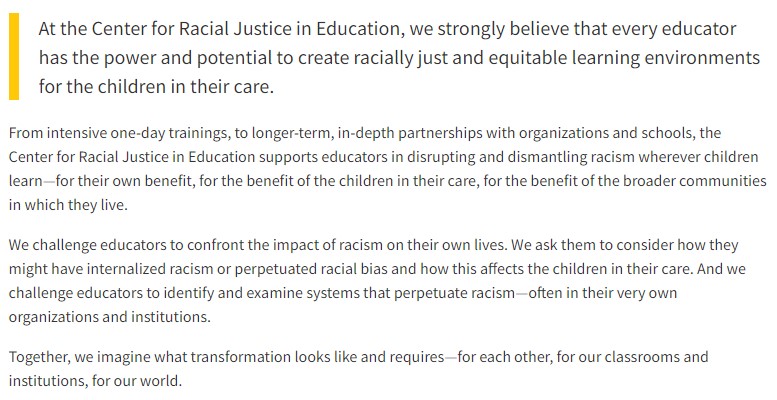
Somerville Public Schools wants students and educators to “experience discomfort”; partners with organizations that promote teaching gender identity to young children
Incidents
The Somerville Public Schools website has an “Equity and Excellence” page to show the school district’s intentions and actions to implement equity. The page features an “Equity Policy” that the school district adopted in November 2019. The policy states that it “exists to confront a legacy of institutional racism that results in achievement and opportunity gaps.” The policy also explains that students in the school district have the right for their “identities” to be “valued”:
Somerville Public Schools (SPS) students have the right to respectful learning environments in which all of their identities, especially their racial and ethnic diversity, are valued and contribute to successful academic outcomes. This includes the embracing of intersectionality, the complexity of each unique student, and the convergence of their overlapping identities (such as race, ethnicity, gender identity, ability, sexual orientation, religion, nationality, language acquisition status, and socio-economic status).
The school district’s “Equity and Excellence” page also features a “Commitment to Equity” presentation for the 2019-2020 school year that the assistant superintendent and director of “Equity and Excellence” appeared to deliver to the School Committee. The presentation has a list of “norms” for the school district to achieve. One “norm” is to “experience discomfort as part of the process of healing and transformation.” The presentation also features a list of “agreements” that includes working “to build community and trust in the spirit of the process norms.” Another agreement is to “know that racially biased systems and processes exist and commit to seeking out and interrupting them.”

The presentation also lists partners that the school district works with. One partner is listed as “Teaching Tolerance.” The organization is now known as “Learning for Justice.” The organization has resources for educators to use while teaching their students. One resource is called the “Social Justice Standards.” The document for these standards includes goals to achieve for students. One goal is that “students will develop language and historical and cultural knowledge that affirm and accurately describe their membership in multiple identity groups.” Another goal appears to outright state that the purpose of the “Social Justice Standards” is to turn students into political activists: “Students will make principled decisions about when and how to take a stand against bias and injustice in their everyday lives and will do so despite negative peer or group pressure.”

Another resource for educators that Learning for Justice provides is called “Gender and Sexual Identity.” The resource explains to “teach the facts about sex assigned at birth, sexual orientation, gender identity and gender expression, and learn how to advocate for LGBTQ youth.” The resource links to another page on the organization’s website that tries to teach the perceived differences among “biological sex,” “gender identity,” “gender expression,” and “sexual orientation.” The organization advocates for teaching young children about gender identity by stating that “studies show that children of any age are able to understand that there are more than two gender categories when the concept is explained to them in a simple, age-appropriate manner.”


The school district has one resource titled “Talking About Racism and Activism.” The resource provides links to the books So You Want to Talk About Race, How to Be an Anti-Racist, and White Fragility. The resource also provides links to several other resources to teach children about “racism and activism.” One link is for the Center for Racial Justice in Education and is labeled “Resources for Talking about Race, Racism, and Radicalized Violence with Kids.” The link to the organization includes articles titled “How should teachers and parents talk to kids about police violence?” and “How should New York City teachers guide conversations about race and police violence?“
The Center for Racial Justice in Education is an organization with a specific purpose of influencing America’s educators. The organization states that its mission “is to train and empower educators to dismantle patterns of racism and injustice in our schools and communities.” The organization further explains that it “supports educators in disrupting and dismantling racism wherever children learn—for their own benefit, for the benefit of the children in their care, for the benefit of the broader communities in which they live.”




The school district also has an “Equity and Excellence” newsletter that promotes the gender neutral term “Latinx” and “intersectional LGBTQ history.” The September 2021 newsletter stated that “the Latinx community is incredibly diverse in race, gender identities, language, and religion.” The term “Latinx” has been adopted by political activists to offer a gender neutral version of the terms “Latino” and “Latina.”
The school district provides additional resources for students to continue learning from home “that have been vetted and recommended by our Somerville curriculum team.” One resource is labeled “Educational TV Shows” and specifically mentions Bill Nye. The link goes to an article titled “62 of the Best Educational Shows on Netflix.” One show on the list is the 2017 series “Bill Nye Saves the World.” One episode of the show is called “Sexual Spectrum” and tries to explain how gender is on a spectrum. The episode has material that can be perceived as vulgar and not suitable for children.

Stay Informed
